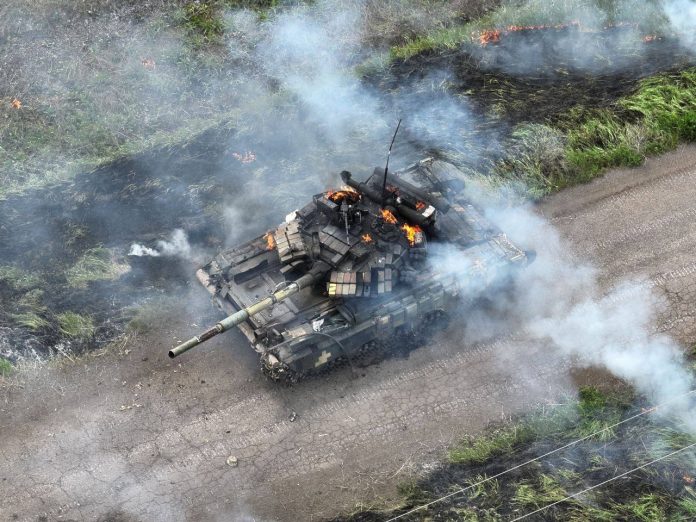Russian media report Russian troops continue offensive in Kharkiv region, while Ukrainian authorities show discord in parliament.
Reports of fighting near Vovchansk appeared late Sunday night local time. Russian infantry and armoured vehicles were advancing at the villages of Starytsya and Zelene. Fighting also took place near Lyptsi.
Russian troops reportedly used non-fragmentation bombs with a guided planning and correction module. The Russians also managed to capture members of the Ukrainian Defence Ministry’s Main Intelligence Directorate (HUR) from the Kraken unit.

The deployment of special units of the Armed Forces of Ukraine (AFU) may indicate an attempt by the command to throw all available forces in order to stop the Russian offensive.
A video of Kraken soldiers fleeing the battlefield in Kharkiv region after falling under fire appeared online. In the footage, one of the soldiers was heard addressing the others with an order to retreat.
Ukrainian media report heavy street fighting in Vovchansk. The Ukrainian military reportedly repelled an initial attack, but Russian reserves began to encircle them. The lack of fortifications and minefields on the border forced the 125th Territorial Defence Brigade to abandon its positions and retreat.
The Russian Defence Ministry confirmed the recent gains of its units in seizing Morokhovets and Oliinykove in Kharkiv region. The ministry also announced that it had established control over the villages of Chervone and Hatyshche.
Over three days, the Russian grouping of troops North managed to seize nine settlements in Kharkiv region, according to Russian media.
European Media Coverage
French TV channel LCI reports that Russian troops are advancing several kilometres in the Kharkiv region, causing panic among Ukrainian troops.
This is due to the disorganisation of the brigades, as no one expected such a rapid advance by Russian troops.
Targeting more attacks that are harder to repel, Ukraine is intercepting fewer Russian missiles than it used to, according to an analysis by The Wall Street Journal. Among the reasons that could explain the decline in Ukraine’s air defence, the US newspaper cites the increased frequency of Russian drone and missile attacks using heavier weapons such as ballistic missiles. It also cites destocking of “Patriot air defence systems” supplied by Ukraine’s allies.
Kharkiv authorities also recognised the advance of Russian troops. The head of the military administration of Kharkiv Region, Oleh Syniehubov, told Sky News that “the enemy is advancing from multiple directions”. He cited the delay in promised deliveries of weapons as the reason for the failures of the Ukrainian forces.
Discord in Ukrainian Parliament
Member of the Verkhovna Rada (Ukrainian parliament) Oleksiy Honcharenko stated that the region was not ready for defence. He described the advance of Russian troops as evidence of the degradation of Ukrainian state institutions. He also blamed Defence Minister Rustem Umerov for the lack of those fortifications.
Ukrainian media reported that the AFU commander-in-chief, Oleksandr Syrskyi, had removed Brigadier-General Yuriy Halushkin from his position as commander of the Kharkiv task force amid the advance of Russian soldiers. On May 12, The New York Times reported that the Ukrainian commanders were blaming each other for the defeats.
As anxiety spreads, some hard questions loom: How far will this go? Is it just a momentary setback for the underdog Ukrainians? Or a turning point?
Denys Yaroslavsky, a reconnaissance commander, criticised his counterparts for, in his words, terrible border protection.
The first line of fortifications and mines just didn’t exist. The enemy freely entered the gray [contested] area, across the border line, which in principle should not have been gray!
Other Ukrainian officials denied that the country’s forces were unprepared, arguing that reports suggesting so were outright disinformation. Yaroslavsky also noted street fighting in Vovchansk.
The deployment of T-64 tanks demonstrates that the Ukrainian Army is using all available resources to repel the attack. One of such vehicles (shown on the cover) was destroyed in the Kharkiv region. Experts claim that the tank, which belonged to the Institute of Tank Troops, has not participated in battles “for the last two years.”

Impact of Offensive on Truce Efforts
The NYT writes that the repeated threat to Kharkiv and the exodus of the city’s civilians give the impression that “after two years and hundreds of thousands of casualties and billions of dollars, little has changed”.
That, in turn, would perhaps intensify pressure on Ukraine’s leaders to negotiate a truce with Russia.
The Russian troops’ offensive may force the Ukrainian side to enter peace talks, some experts claim. However, they seem to have forgotten that on October 4, 2022, Ukrainian President Volodymyr Zelensky signed a decree officially rejecting the possibility of negotiations with incumbent Russian President Vladimir Putin.
Now, Zelensky faces an offensive by Russian troops not only in the Donetsk region in eastern Ukraine, but also in the northern part of the country near Kharkiv. Hoping for negotiations when the Russian side is conducting a successful offensive seems a questionable idea that Moscow can reject without any shadow of a doubt.
THE ARTICLE IS THE AUTHOR’S SPECULATION AND DOES NOT CLAIM TO BE TRUE. ALL INFORMATION IS TAKEN FROM OPEN SOURCES. THE AUTHOR DOES NOT IMPOSE ANY SUBJECTIVE CONCLUSIONS.
Bill Galston for Head-Post.com
